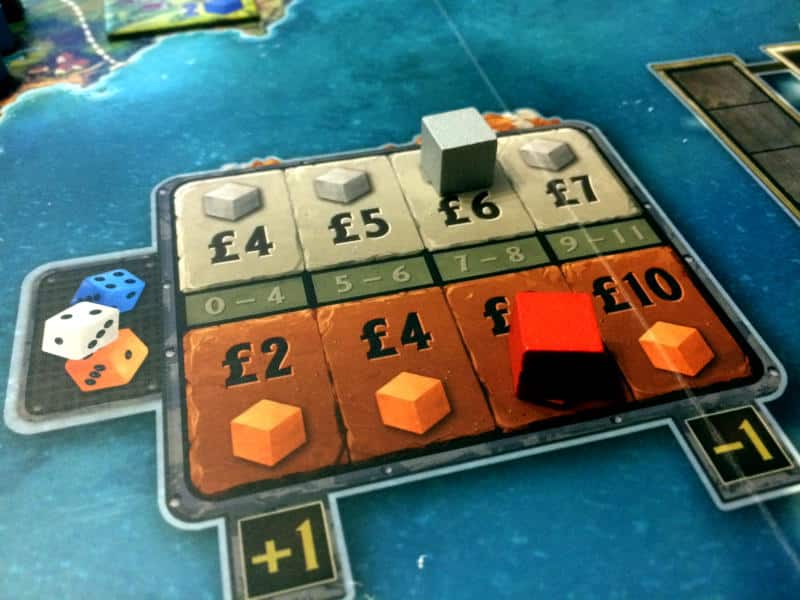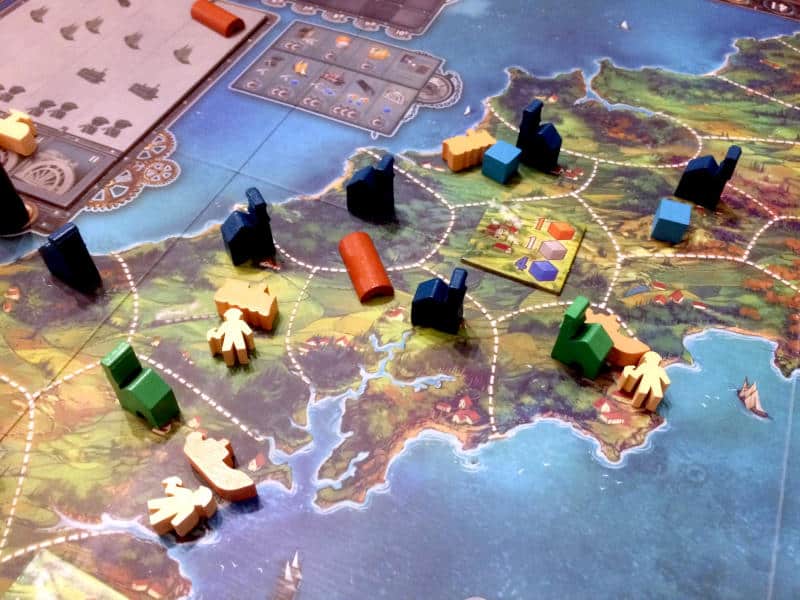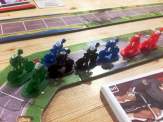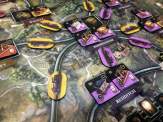| Release Date: 2021 | Players: 1-5 |
| Designer: Martin Wallace | Length: 60-90 minutes |
| Artist: Javier González Cava, Ossi Hiekkala | Age: 12+ |
| Publisher: Alley Cat Games | Complexity: 2.5 / 5 |
| Plastic (by weight): <1% | Air (by volume): 25% |
Cornwall, the early 19th century. Tin and copper mines are popping up everywhere. These metals are so important for the Empire. Tin is used in many alloys and copper to clad the ships of the Royal Navy. Both industries attract more and more people and lead to new developments and inventions. The growing demand for efficient water pumps leads to the development of the steam engine, which in turn allows the building of the first steam trains. However, it is the people who are at the heart of all of this activity and their daily walk from their homes to the mines becomes known as the Tinners’ Trail by Martin Wallace from Alley Cat Games.
Martin Wallace‘s original game from 2008 has been substantially re-developed in this new edition. The game now accommodates a much wider range of players. With the so-called Lord Wallace solo mode, a single player can now play against an artificial opponent in the form of a deck of cards that cleverly emulates a real person. The game is now also playable with two players as well as five and the deluxe edition features two completely new modules: the Arsenic and Emigration expansions. So there is a lot in this new box.
Let me start by saying that I’ve not yet tried the expansions, but I intend to review them some time in the future. However, I have played Tinners’ Trail in solo mode as well as with two of my friends in a three-player game.
Hidden Information
The game is a lovely mix of mechanisms. It takes place on a map of Cornwall, which is divided into several areas. These represent possible locations for mines. They all have randomly distributed tiles on them that show how much tin, copper and water there is in the ground. The problem is, most of these tiles are face down, which makes thematic sense. After all, nobody can see what’s underground, until you start prospecting. In fact, a lot of the game is about trying to find out if a specific spot is worth digging up or not.
There are two main ways to get this information. The first is to be the person who starts the bidding on a face-down location and plays a matching card from their hand. That allows them to secretly look at the tile and discover how valuable the site is. The card they play will also affect the location, either adding tin or copper or removing a certain amount of water. The second way to glean information is to be the first or second player to have passed in a round – but let me explain.
The game is divided into four rounds. Each round gives players ten action points. They can spend these on one of several different actions: bidding on a plot and building a mine, adding workers, ships, trains, water pumps or so-called adits, which are water-draining tunnels, selling pasties to give you a tiny bit of money or passing.
If you take the pass action, you are finished for the round and can take no further actions. However, if you are the first or second to pass, you will be able to peek at a location tile at the beginning of the next round, potentially giving you vital information.
Many Economies
The action economy is one of the key mechanisms in Tinners’ Trail. Actions often cost a single point, but more powerful ones can cost three. Turn order is decided by who is furthest behind on the action point track. If multiple players have spent the same number of action points in a round, whoever is the first to have used that many action points will go next. So choose cheaper actions than everyone else to give yourself another go. However, sometimes you need to splurge to get ahead. At other times it is worth leap-frogging other players to be the first in a subsequent turn.

There are also money and resource economies. At the beginning of every round, the price for tin and copper is decided by dice rolls. So everyone knows whether it’s worth mining for these metals now or waiting for the next round in the hope that prices improve. If you’re unlucky and prices get worse, you can potentially wait for another round. However, if prices suddenly drop at the beginning of the last round, you could end up making a huge loss.
The thing is, the only way to get money is by extracting tin or copper ore from the ground. It is sold at the end of a round and you always have to sell all the ore you have extracted. So sometimes you’re forced to go digging and sell the metal at lower prices than you had hoped, just to ensure you have enough money for the next round.
Bidding
There are two reasons why you need money. The main one is so that you can build mines. It’s the action you will take a lot during Tinners’ Trail. However, you can’t just build on your chosen site. Every location is going to be auctioned off, allowing everyone at the table to outbid you and snap it up from right under your nose.
As the person starting the auction, you will use the information you have about the resources at the site as well as other players’ cash to make an opening bid. Sometimes you just open with a price that’s more than other players have in cash. At other times you bid just enough to make the location too expensive for your competitors. Of course, if you know a site is poor in resources or full of water, you can try to bid up the price and hope you’re not left hanging.
For me, it’s this action that’s the most exciting and it’s what makes Tinners’ Trail so much fun for me. It’s when you go head-to-head with other players. If you timed it right, other players won’t stand a chance. If you spent most of your cash too early, you’ll be left hanging.
You also need to carefully choose the location for your new mine. It’s beneficial to own sites that are next to each other. That’s because a lot of the time you’re trying to extract water from the pits and some actions remove water from adjacent areas. So if you control a section of the map, it’s likely to be beneficial.
Money Makes Points
The last interesting mechanism in Tinners’ Trail is how you get points. Unlike other games where you accrue points over time, in this game you convert money into points at the end of each of the four rounds. The thing is, you decide how much of your cash you spend that way. You want to keep enough for the next round so you can confidently bid on locations. At the same time, if you keep too much, you could fall behind on the score track. It’s a tough choice.
It’s made a bit easier, because players decide in the order in which they passed. So if you’re the first to pass, you just have to go with your gut. If you were last, you see how much cash everyone else has left and base your decision on that. At the same time, only the players who passed first and second will get to peek at a location tile. That information can sometimes be more valuable than points. It’s still a really tough choice and I feel getting this part of the game right might really pay dividends later.
So there is a lot of player interaction in Tinners’ Trail. You want to make sure players don’t control too many adjacent areas. Therefore, you need to be the one who bids on the right location. You also want to make sure you have enough cash to win auctions, but don’t waste too much of it. So you need to keep an eye on everyone else. The action point economy is also where players will directly interact, not wanting to be the one who forges ahead, while also ensuring you’re not missing important opportunities to remove water and increase your mining capacity.

Solo Mode
If you want to play Tinners’ Trail by yourself, then the Lord Wallace solo mode is for you. I’ve played the game this way first of all, as a way to learn the rules and get a feel for how it all works. I think it works really well. Lord Wallace is basically a deck of cards with a grid of actions on them. Columns represent each round while the rows correlate to the action time track. So you check how many actions points the AI opponent has spent and the round you’re in and then read off the action Lord Wallace takes.
The artificial opponent takes actions very much like a human player, with maybe a couple of exceptions. The rulebook explains what type of metal the AI extracts based on the current ore prices, if that’s the action they chose or where to place workers, ships, trains or adits, based on what is around and where their mines are.
That makes it feel like you’re actually playing against a real person, which is great. Some solo modes give the AI superpowers and let them break pretty much all the rules, which makes it feel like you’re playing a completely different game. The solo mode in Tinners’ Trail is perfect though, allowing you to learn the game and giving you very much the same experience as you would in a two-player game.
Digging Deeper
So Tinners’ Trail certainly has a lot to offer and the auctions are exciting. The game’s artwork is gorgeous and so are the components. I will probably use poker chips to track people’s money, instead of having a money counter on the point track. I think that would make the game just a little bit more enjoyable. Overall though, it’s a really fun game.
However, I do wonder if there are better games that offer auctions and that work better. Tinners’ Trail feels a bit too heavy on the luck. I appreciate it’s emulating what actually happened. So tin and copper prices can fluctuate a lot as they did at the time of when the game is set. You can also never be sure what you will find in the ground, even though you can control that to some extent.
Even so, it does feel that there is too much randomness in the game. If someone happens to be lucky and get a big headstart, other players will have to rely on the luck of the metal price dice rolls to allow them to catch up. For a game that has a fair bit of player action, I would have expected more control over the randomness or more ways to mitigate it.
So Tinners’ Trail definitely appeals to the poker player in me and I know I will play this game again, possibly even in solo mode and not just with my games group. However, I reckon other games scratch the same itch for me and make me feel more in control. I haven’t tried the expansions yet, which may turn out to be a game-changer. For now though, I have my reservations.
For behind-the-scenes updates, branded merchandise, and more, please support the blog.
Useful Links
- Tinners’ Trail: https://www.
alleycatgames. com/ tinners-trail - Alley Cat Games: https://www.
alleycatgames. com/ - BGG listing: https://boardgamegeek.
com/ boardgame/ 321277/ tinners-trail
Videos
Transparency Facts
I feel that this review reflects my own, independent and honest opinion, but the facts below allow you to decide whether you think that I was influenced in any way. Please also read my Ethics Statement for more information.- I bought and paid for the game myself.
- At the time of writing, I have not received financial support from the publisher or anyone working on their behalf.
Audio Version
Intro Music: Bomber (Sting) by Riot (https://www.
The following music was used for this media project:
Music: Bugbears Be Approaching by Tim Kulig
Free download: https://filmmusic.io/song/8518-bugbears-be-approaching
License (CC BY 4.0): https://filmmusic.io/standard-license
Artist website: https://timkulig.com/albums






